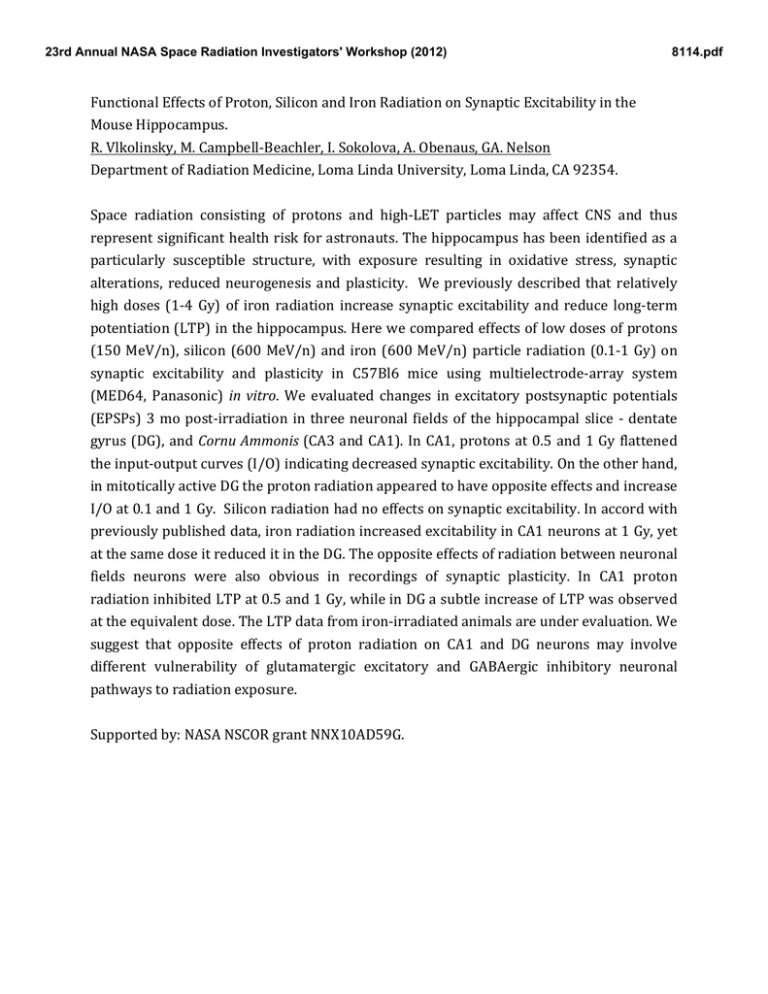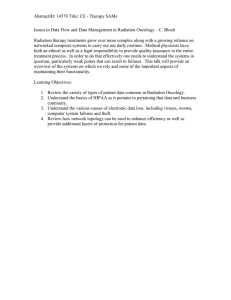Document 14553356
advertisement

23rd Annual NASA Space Radiation Investigators' Workshop (2012) 8114.pdf Functional Effects of Proton, Silicon and Iron Radiation on Synaptic Excitability in the Mouse Hippocampus. R. Vlkolinsky, M. Campbell-­‐Beachler, I. Sokolova, A. Obenaus, GA. Nelson Department of Radiation Medicine, Loma Linda University, Loma Linda, CA 92354. Space radiation consisting of protons and high-­‐LET particles may affect CNS and thus represent significant health risk for astronauts. The hippocampus has been identified as a particularly susceptible structure, with exposure resulting in oxidative stress, synaptic alterations, reduced neurogenesis and plasticity. We previously described that relatively high doses (1-­‐4 Gy) of iron radiation increase synaptic excitability and reduce long-­‐term potentiation (LTP) in the hippocampus. Here we compared effects of low doses of protons (150 MeV/n), silicon (600 MeV/n) and iron (600 MeV/n) particle radiation (0.1-­‐1 Gy) on synaptic excitability and plasticity in C57Bl6 mice using multielectrode-­‐array system (MED64, Panasonic) in vitro. We evaluated changes in excitatory postsynaptic potentials (EPSPs) 3 mo post-­‐irradiation in three neuronal fields of the hippocampal slice -­‐ dentate gyrus (DG), and Cornu Ammonis (CA3 and CA1). In CA1, protons at 0.5 and 1 Gy flattened the input-­‐output curves (I/O) indicating decreased synaptic excitability. On the other hand, in mitotically active DG the proton radiation appeared to have opposite effects and increase I/O at 0.1 and 1 Gy. Silicon radiation had no effects on synaptic excitability. In accord with previously published data, iron radiation increased excitability in CA1 neurons at 1 Gy, yet at the same dose it reduced it in the DG. The opposite effects of radiation between neuronal fields neurons were also obvious in recordings of synaptic plasticity. In CA1 proton radiation inhibited LTP at 0.5 and 1 Gy, while in DG a subtle increase of LTP was observed at the equivalent dose. The LTP data from iron-­‐irradiated animals are under evaluation. We suggest that opposite effects of proton radiation on CA1 and DG neurons may involve different vulnerability of glutamatergic excitatory and GABAergic inhibitory neuronal pathways to radiation exposure. Supported by: NASA NSCOR grant NNX10AD59G.




